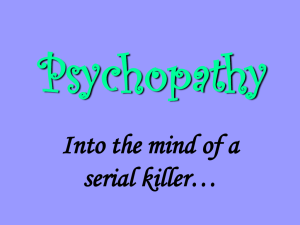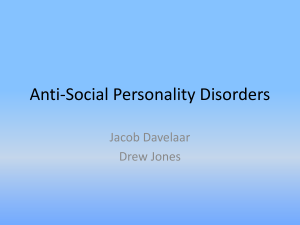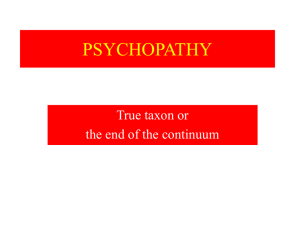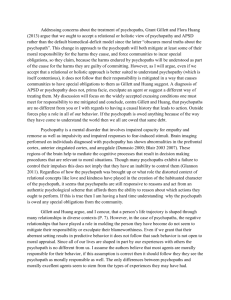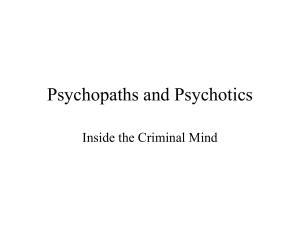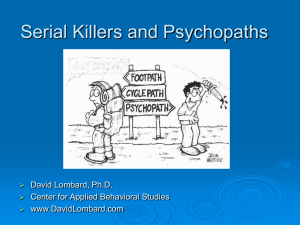Total Selfishness - Center for Neuroscience & Society
advertisement
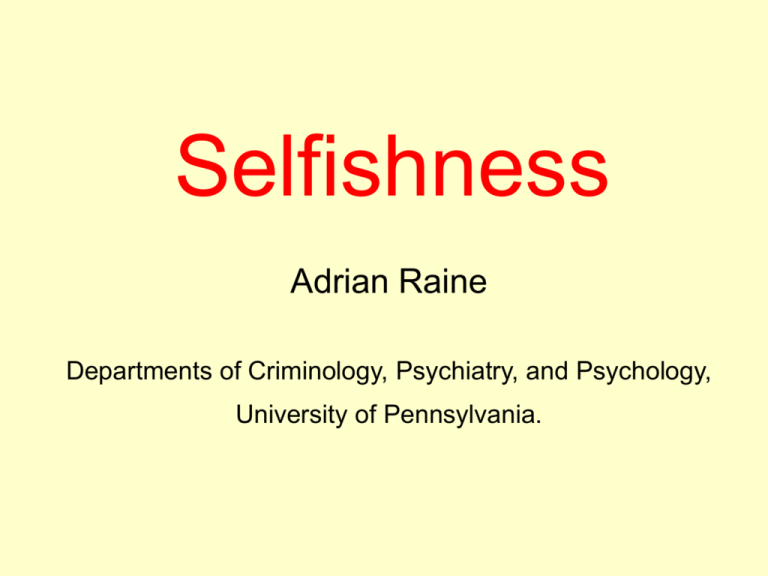
Selfishness Adrian Raine Departments of Criminology, Psychiatry, and Psychology, University of Pennsylvania. Overview 1. Nature of Selfishness 2. The Selfishness Questionnaire 3. Neural Basis of Selfishness 4. Future Directions Definition “Exclusive focus on one’s own well-being without concern for others” Three Forms of Selfishness 1. Egocentric Selfishness 2. Adaptive Selfishness 3. Pathological Selfishness Selfishness Questionnaire 2 = Agree; 1 = Neither Agree nor Disagree; 0 = Disagree Overview 1. Nature of Selfishness 2. The Selfishness Questionnaire 3. Neural Basis of Selfishness 4. Future Directions 1. Egocentric Selfishness I don't give to charities 68% vs 11% Even when I see people in need, I don't feel urge to help them When it comes to helping myself or others, I help myself 53% no vs 12% yes I admit I'm quite a selfish person 51% no vs 19% yes I care a lot about getting what I want I like buying things for myself even though I have enough 21% no vs 56% yes I have enough in life to live on, but there are times I just want more 2. Adaptive Selfishness If there was only one space left on a lifeboat that a child needed, I’d honestly have to take it for myself and my family. 32% no, 29% yes If the choice was between killing someone or being killed, I'd kill I would not try to save a drowning person if I could drown too 51% no vs 17% yes You need to help your own family first before you help others. Having a focus on oneself can be very adaptive in life People need to be a little selfish for positive social change to occur 27% no vs 33% yes Dealing with my own needs, I can make the world a better place 38% no vs 23% yes 3. Pathological Selfishness Now and again I've manipulated friends to gain an advantage It’s not nice to exploit others, but sometimes you simply need to 54% no 16% yes It’s hard to get ahead in life unless you cut other people's corners here and there I have to look after myself, even if it costs a loved one 51% no vs 15% yes I’ve sometimes dumped friends I don't need 58% no vs 20% yes Even if it would cause the other person to become depressed, I’d end the relationship if it’s in my best interest 24% no vs 45% yes I love rewards in life, even if there is a cost to others Selfishness Scale 39 items N = 230 Total score and three subscales 2 = Agree 1 = Neither Agree nor Disagree 0 = Disagree Subscale Mean SD Range Egocentric Adaptive Pathological 10.62 12.38 10.62 4.56 4.66 4.89 1 - 22 1 - 25 0 - 24 Total 33.60 11.94 6 - 64 Adaptive higher than Egocentric and Pathological (d = .38, p < .0001) Effect Sizes – Cohen’s d Aspirin and reduction in death from heart attack d = .04 Smoking and lung cancer d = .16 SAT scores and later college GPA d = .40 Attention scores and Attention Deficit Disoder d = .60 (Meyer, 2001) Small effect size: d = .2 Medium effect size: d = .5 Large effect size: d = .8 Correlations (range 0 to 1): approximately half of d Adaptive higher than Egocentric and Pathological (d = .38, p < .0001) Construct Validity – Warmth & Altruism Altruism I go out of my way to help others if I can I generally try to be thoughtful and considerate Warmth I’m known as a warm and friendly person I have strong emotional attachments to my friends Total Selfishness r Altruism Warmth -.45 -.24 Construct Validity - Empathy Cognitive Empathy When two people argue I can see each other’s point of view. When someone is disappointed, I can tell by how they look. Affective Empathy If I saw my friend being made a fool of, I would feel uncomfortable. Seeing people sad at a funeral would make me feel sad too. Total Selfishness r Cognitive Empathy Affective Empathy -.19 -.28 Construct Validity - Psychopathy Psychopathy I don't care much if what I do hurts others. I get in trouble for not considering the consequences of my actions. Total Selfishness r Psychopathy .38 Construct Validity – Proactive and Reactive Aggression Proactive Aggression Hurt others to get ahead. Used physical force to get others to do what you want. Reactive Aggession Yelled at others when they have annoyed you. Reacted angrily when provoked by others. Total Selfishness r Proactive Aggression .38 Reactive Aggression .26 Construct Validity – Narcissism + Histrionic Narcissistic I expect other people to do favors for me even though I do not usually do favors for them. People have often complained that I did not realize that they were upset. Histrionic I need to be the center of attention. I have a flair for the dramatic. Narcissistic Histrionic Total Selfishness r .44 .29 Construct Validity - Antisocial and Machiavellian Antisocial I don’t care if others get hurt so long as I get what I want I do a lot of things without considering the consequences Machiavellian I sometimes try to get others to “bend the rules” for me if I can’t change them any other way. In school or at work, I sometimes try to “stretch” the rules a little bit just to see how much I can get away with. Antisocial Machiavellian Total Selfishness r .29 .60 Discriminant Validity: Depression + Anxiety Depression Sometimes I feel completely worthless Sometimes things look pretty bleak and hopeless to me Anxiety I often feel tense and jittery Frightening thoughts sometime come into my head Total Selfishness r Depression Anxiety .10 .02 Discriminant Validity – Assertive + Schizotypy Assertive I have often been a leader of groups I have belonged to Other people often look to me to make decisions Schizotypal Personality (Odd Beliefs / Magical Thinking) Do you believe in telepathy? Can other people feel your feelings when they are not there? Total Selfishness r Assertiveness .00 Schizotypy .10 Discriminant Validity – “Too Good” I sometimes get upset. Occasionally I talk about people behind their backs There are some people that I don’t like I have never told a lie Total Selfishness r “Too Good” .08 Three Factors of Selfishness (r) Total Ego Pathol. Adapt. Altruism Warmth -.45 -.24 -.45 -.20 -.40 -.19 -.27 -.17 Cognitive Empathy Affective Empathy -.19 -.28 -.15 -.25 -.19 -.27 -.12 -.14 Psychopathy Proactive Aggression Reactive Aggression .38 .38 .26 .32 .32 .24 .47 .44 .28 .15 .21 .13 Narcissistic Histrionic Antisocial Machiavellian .44 .29 .29 .60 .41 .31 .25 .51 .38 .25 .36 .58 .33 .21 .15 .45 Sex Differences Females Males p = .04 d = .30 35 30 25 20 p = .02 d = .33 15 10 5 0 Ego Adaptive Pathological Total Ethnic Differences Total Selfishness Caucasian Latino African-Am Asian 38 37 36 35 34 33 32 31 30 29 28 Asians more selfish than Caucasians (p < .008, d = .44) Ethnic Differences – Selfishness Subtypes Adaptive Selfishness Caucasian Latino African-Am Ego Selfishness Asian 15 14.5 14 13.5 13 12.5 12 11.5 11 10.5 10 Caucasian Latino African-Am Asian 14 13 12 11 10 9 8 Asians (p = .003, d = .47) more Adaptively Selfish than Caucasians Latinos (p = .017) and Asians (p = .005) more Ego Selfish than Caucasians Family Income and Adaptive Selfishness Adaptive Selfishness 15 14 13 12 11 10 under 25k 25 50k 50 75k 75 100k over 100k 25k – 75k more Adaptively Selfish than all others (d = .48 to .81) Major and Adaptive Selfishness Adaptive Selfishness 15 14 13 12 11 10 Psych. Bus. Eng./NS Soc. Engineering / Natural Sciences Majors more Adaptively Selfish than all others (d = .43 to .66) Overview 1. Nature of Selfishness 2. The Selfishness Questionnaire 3. Neural Basis of Selfishness 4. Future Directions Where is selfishness in the brain? 9. ACQUISITIVENESS: Economy: the disposition to save and accumulate property. Excess: Miserly avarice: theft; extreme selfishness. Deficiency: Prodigality; inability to appreciate the true value of property; lavish and wasteful Amygdala and Psychopathy Yang et al., (2009). Archives of General Psychiatry 27 psychopaths vs. 32 non-psychopaths Psychopathy and Rewards; Striatum Striatum 9.6% volume increase in psychopaths Glenn et al. (2010) Biol. Psychiatry, 67, 52-58 Ventral Striatum Psychopathic traits: Reward hypersensitivity Buckholtz et al. (2010) Nat. Neuro. 13, 419-421 Giving Activates Ventral Striatum Harbaugh et al. (2007) Reflecting on Self vs Others Jenkins & Mitchell (2011) self-referential: anterior dorsal MPFC perspective-taking: posterior dorsal MPFC Argembeau et al. (2007) Future Directions Immediate: Behavioral Validation • E.g., Dictator Game • Behavioral reflection of selfishness through cooperation • Different dimensions of SQ Cross-cultural: Dharamsala, India • Emory-Tibet Science Initiative • Tibetan monks at monasteries • Compassion-meditation lifestyle change selfishness? Long-term: Does mindfulness reduce excessive selfishness in US populations? Psychopathy Psychopathy: Constellation of Interpersonal, Affective, Lifestyle, and Antisocial characteristics (Hare, 1999) Total Psychopathy Factor 1 Facet 1: Interpersonal Superficial charm, manipulative, grandiosity Factor 2 Facet 2: Affective lack remorse/guilt, shallow affect, callous, lack empathy Facet 3: Lifestyle Facet 4: Antisocial impulsive, parasitic, irresponsible early behavioral problems, juvenile delinquency Factors of Psychopathy Hare Psychopathy Checklist – Revised (Hare, 2003) 1. Arrogant / deceitful Glib Grandiose Pathological lying Conning / manipulative 2. Deficient affect Lacks remorse / guilt Shallow affect Callous / lacks empathy Fails to accept responsibility 3. Impulsive – unstable Need for stimulation Parasitic lifestyle Lacks realistic, long-term goals Impulsivity Irresponsibility 4. Antisocial Poor behavioral controls Early behavior problems Juvenile delinquency Revokes conditional release Criminal versatility Construct Validity Total Selfishness r Altruism Warmth -.45 -.24 Cognitive Empathy Affective Empathy -.19 -.28 Psychopathy .38 Proactive Aggression .38 Reactive Aggression .26 Narcissistic Histrionic Antisocial Machiavellian .44 .29 .29 .60 Discriminant Validity – Assertive + Schizotypy Assertive I have often been a leader of groups I have belonged to Other people often look to me to make decisions Assertiveness .00 Schizotypy .10 “Too Good” .08 Assertiveness Schizotypy .10 .02 Narcissistic Personality Disorder: DSM 5 Definition Pervasive grandiosity, need for admiration, lack of empathy A. 5 or more of: (1) grandiose sense of self-importance (exaggerates talents) (2) fantasizes unlimited success/power/brilliance/beauty/love (3) believes special/unique; only understood by high status (4) requires excessive admiration (5) sense of entitlement (favorable treatment) (6) interpersonally exploitive (takes advantage or others) (7) lacks empathy (won’t recognize feelings / needs of others (8) often envious of others / believes others envious of them (9) arrogant / haughty behavior or attitudes Borderline Personality Disorder: DSM 5 Definition Pervasively instability of relationships, self-image, affect & marked impulsivity; begins early adulthood, multiple contexts A. 5 or more of: (1) frantic effort to avoid real / imagined abandonment (2) unstable / intense interpersonal relationships (3) identity disturbance (unstable self-image) (4) impulsivity in 2 areas (spending/sex/drugs/binges/driving) (5) recurrent suicidal behavior / gestures / threats / mutilation (6) affective instability (dysphoria, irritability, anxiety) (7) chronic feelings of emptiness (8) inappropriate, intense anger (temper/anger displays/fights) (9) transient, stress-related paranoia or dissociation Psychopathy Psychopathy: clinical construct of a constellation of interpersonal, affective, lifestyle, and antisocial characteristics (Hare, 1999) Total Psychopathy Factor 1 Facet 1: Interpersonal Superficial charm, manipulative, grandiosity Factor 2 Facet 2: Affective lack remorse/guilt, shallow affect, callous, lack empathy Facet 3: Lifestyle Facet 4: Antisocial impulsive, parasitic, irresponsible early behavioral problems, juvenile delinquency 1. Pathological Selfishness Sometimes need to take advantage of others before they do of you Times when I put myself first, even if it's someone's loss Have to look after myself even if cost to my loved one Go out of my way to exploit situations for own advantage Now and again I've manipulated friends to gain advantage Hard to get ahead unless you cut other people's corners Not nice to exploit others but sometimes you have to . Giving my kids unfair advantage over others I like voicing my opinions even if they offend I like having "me" time even if others disappointed End a relationship even if causes person to be depressed I love rewards in life even if there is a cost to others Sometimes dump friends I don't need anymore 2. Adaptive Selfishness Choice between killing someone or being killed, I'd kill Need to help own family first People need to be selfish for positive change Take one space for myself and family in lifeboat even if child needed it Not try to save drowning person if I could drown too It's not good to be too modest Not always honest because honesty can harm myself and others Focus on my concerns first, better able to help others Better to save for a rainy day Sometimes lie to others for my own good, and theirs too Having a focus on oneself can be adaptive Deal with my own needs, can make the world better place Don't give to charities because I need to help my family and myself more Not always honest because honesty can harm myself and others 3. Egocentric Selfishness Don't feel urge to help people I see in need Care for myself much more than for others When it comes to helping myself or others, I help myself I care a lot about getting what I want Really want things, even when I don't need them I don't like paying for friends meals Rarely give money to homeless I admit I'm quite a selfish person I don't give to charities Have enough in life to live on but times I just want more Discuss my own life rather than theirs Like buying things even when I have enough I don't think I give to others as much as I receive PSYCHOPATHY 1. Clinical manifestation 2. Etiology: Parental bonding Mind-body connection Temperament Brain mechanisms 3. “Successful” vs. “Unsuccessful psychopaths” Introduction to Psychopathy • Cleckley “The Mask of Sanity” • Terminology - “moral insanity” Pritchard (1837) - “sociopathy” DSM (1952) - “psychopathy” (“Psychopathic inferiority, Koch 1888) • Relationship to APD and “sociopathy” • Base-rate in society • Demographics - gender - ethnicity - age David Krueger: Features of Psychopathy (1) lack of remorse / guilt: lacks sense of shame (2) callous / lacks empathy: disregard for others’ suffering (3) conning / manipulative: persuaded another to help kill (4) deception: deceived lover to walk in grounds (5) need for stimulation: curious about what it feels like to kill (6) glib: quick and clever comeback to Q on prior killings (7) revokes conditional release: killing on 1st day-pass (8) grandiose: spurned lover, wants to be on top (9) shallow affect / sexuality: no sense of deep love PSYCHOPATHY 1. Clinical manifestation 2. Etiology: Parental bonding Mind-body connection Temperament Brain mechanisms 3. “Successful” vs. “Unsuccessful psychopaths” Parental Bonding and Psychopathy Gao et al. (2010) Psychological Medicine, 40, 1007–1016. Concurrent design 330 male and female community participants, aged 28 Parental Bonding Instrument aged 28 (retrospective bonding) Hare’s self-report psychopathy scale age 28 Longitudinal Design 6 participants separated from both parents before age 3 Parental Bonding Instrument aged 28 (retrospective bonding) Hare’s self-report psychopathy scale age 28 Warmth scale “Was affectionate to me” Overprotection scale “Was overprotective of me” Loss of Parents at Age 3 and Parental Bonding Gao et al., (2010) z score Lacking parents (N = 6) With Parents (N = 327) 0 -0.2 -0.4 -0.6 d = .90 -0.8 p = .02 d = .72 p = .08 -1 Mothers's Care Father's Overprotection Parental Separation at 3 and Psychopathy at 28 Gao et al., (2010) Concurrent Design Maternal Care – Adult Psychopathy: Psychopathy 250 245 240 235 230 r = -.38, p < .001 Longitudinal Design p = .007 d = .95 Lacking parents (N = 6) 225 220 215 210 With Parents (N = 327) 205 200 Total PSYCHOPATHY 1. Clinical manifestation 2. Etiology: Parental bonding Mind-body connection Temperament Brain mechanisms 3. “Successful” vs. “Unsuccessful psychopaths” Mind-Body Connectedness “We feel sorry because we cry, angry because we strike, afraid because we tremble”. (James, 1884) • Emotional experiences arise directly from perception of bodily change SOMATIC MARKER HYPOTHESIS AND PSYCHOPATHY (Bechara et al. 1997) Patients with ventromedial lesions: (a) don’t give SCRs to socially disturbing pictures (b) perform poorly on decision-making (gambling) task (c) don’t give anticipatory SCRs before making risky decision (d) make bad life decisions (e) exhibit psychopathic-like behavior Unresolved Question: Do psychopaths have deficits in accurate perception of somatic (bodily) sensations? Somatic Aphasia in Psychopaths Gao et al. (2012) Biological Psychology, 90, 28 – 233 Social Stressor Task Rest 1 minute Speech Preparation Speech Presentation 2 minutes 2 minutes Rest 1 minute Psychophysiological Recording Bodily sensation measure Bodily Sensation Measure “How much did you experience the following body feelings when preparing and giving your speech?” (1= not at all, 2 = a little, 3 = sometimes, 4 = often, 5 = very often) • • • • • • • lump in throat breathing changes stomach sensations feel cold feel hot heart pounding tense muscles • • • • • • • perspiration goose pimps facial blushing jelly legs hands tremble voice trembling eyes well with tears Heart Rate Heart Rate Psychopathy x Body Group interaction (p < .05) High bodily sensation group p < .01 Low bodily sensation group Heart Rate Low bodily sensation group p > .45. High bodily sensation group SC Skin Conductance p < .01 High bodily sensation group Low bodily sensation group SC n.s.d High bodily sensation group Low bodily sensation group PSYCHOPATHY 1. Clinical manifestation 2. Etiology: Parental bonding Mind-body connection Temperament Brain mechanisms 3. “Successful” vs. “Unsuccessful psychopaths” Age 3 Temperament and age 28 Psychopathy Glenn et al., (2007) Journal of Abnormal Psychology N = 330 Age 3 y z score 0.15 0.1 d=.40 d=.32 High psychopathy (age 28) Low psychopathy (age 28) 0.05 0 -0.05 -0.1 -0.15 -0.2 -0.25 -0.3 Tommy Lynn Sells Fearlessness Stimulation Seeking PSYCHOPATHY 1. Clinical manifestation 2. Etiology: Parental bonding Mind-body connection Temperament Brain mechanisms 3. “Successful” vs. “Unsuccessful psychopaths” Psychopathy and Rewards; Striatum Striatum 9.6% volume increase in psychopaths Glenn et al. (2010) Biol. Psychiatry, 67, 52-58 Ventral Striatum Psychopathic traits: Reward hypersensitivity Buckholtz et al. (2010) Nat. Neuro. 13, 419-421 Amygdala and Psychopathy Yang et al., (2009). Archives of General Psychiatry 27 psychopaths vs. 32 non-psychopaths Reduced Amygdala in Callous-Unemotional Children (N = 300) Amygdala Volume p = .007 7.4% 3100 2900 2700 2500 2300 p = .003 8.1% 2100 1900 1700 p = .07 6.5% 1500 1300 Total Amygdala Controls Left Amygdala Right Amygdala Callous-Unemotional Reduced Amygdala Volumes in Chinese Murderers Amygdala Volume p = .034 1690 1670 1650 . 3 5 1630 1610 1590 1570 1550 1530 8.8% Normal SchizoPrenia Murderers Schizophrenic Murderers Psychopathy - Amygdala Correlations in Each Group Correlation (r) CONTROLS SCHIZOPHRENIA HOMICIDE SCHIZ-HOMICIDE 0 -0.1 . 3 5 -0.2 -0.3 -0.4 n.s. p < .05 -0.5 p < .02 -0.6 -0.7 -0.8 -0.9 -1 p < .001 Cavum Septum Pellucidum is associated with: higher psychopathy scores increased proactive aggression diagnosis of disruptive behavior disorder CAUSES OF PSYCHOPATHY Evolution Genetics Maternal bonding Family environment Stimulation-seeking & low arousal Classical conditioning Lack of anticipatory fear Neurodevelopmental - CSP Hormones: Lower cortisol in prison psychopaths (Holi et al. 2006; O’Leary et al. 2007; Cima et al. 2009) Increased testosterone to cortisol ratio in psychopaths (Glenn et al. 2011) PSYCHOPATHY 1. Clinical manifestation 2. Etiology: Parental bonding Mind-body connection Temperament Brain mechanisms 3. “Successful” vs. “Unsuccessful psychopaths” Successful vs Unsuccessful Psychopaths (Ishikawa et al., 2001) 91 males from Temp. Agencies assessed on: • Psychopathy Checklist - Revised • Interpersonal Measure of Psychopathy • Self-Report Crime • Court Records • SCID-I • SCID-II PCL-R Score 13 Successful Psychopaths 16 Unsuccessful Psychopaths 26 Controls 27.7 31.5 10.8 Prefrontal Structure / Function (a) Autonomic Stress Reactivity (c) Prefrontal Gray Volume 0.046 Controls 0.044 Unsuccessful Psychopaths Successful Psychopaths 0.042 0.04 0.038 b.p.m. volume / brain ratio 0.048 0.036 0.034 Left Hemisphere 82 80 78 76 74 72 70 68 66 Right Hemisphere Executive Functioning 1.5 1.1 0.7 0.3 -0.1 -0.5 -0.9 -1.3 Controls Unsuccessful Psychopaths Successful Psychopaths Baseline Stress 1 Stress 2 Stress 3 (d) Skin Conductance 6.6 microsiemens scaled score (b) Heart Rate Controls 5.6 Unsuccessful Psychopaths Successful Psychopaths 4.6 3.6 2.6 Controls Successful Unsuccessful Psychopaths Psychopaths Baseline Stress 1 Stress 2 Stress 3 Unsuccessful Psychopaths: - poor frontal functioning - low autonomic reactivity - reduced prefrontal gray Successful Psychopaths: - better frontal functioning - high autonomic reactivity - increased prefrontal gray heightened autonomic and frontal functions promotes good decision-making and sensitivity to cues of risky situations that help some psychopaths avoid detection. SUMMARY: PSYCHOPATHY 1. Clinical manifestation: four main factors 2. Etiology: early bonding; mind-body disconnect; temperament; amygdala – striatum. 3. “Successful” vs. “Unsuccessful psychopaths”: executive functions; arousal, PFC gray Basolateral nucleus Lateral nucleus Add Marsh 2011 on OFC-amyg connectivity in moral decisions in kids Psychopathy and Rewards; Striatum Striatum 9.6% volume increase in psychopaths Glenn et al. (2010) Biol. Psychiatry, 67, 52-58 Ventral Striatum Psychopathic traits: Reward hypersensitivity Buckholtz et al. (2010) Nat. Neuro. 13, 419-421 Psychopathy and Rewards Striatum 9.6% volume increase in psychopaths Glenn et al. (2010) Biol. Psychiatry, 67, 52-58 Ventral Striatum Psychopathic traits: Reward hypersensitivity Buckholtz et al. (2010) Nat. Neuro. 13, 419-421 Psychopathic individuals: striatal hyper-responsivity to anticipation of monetary rewards (Buckholtz et al. 2010) Striatal functions: reward sensitivity: enhanced learning to rewards dramatic response to drugs of abuse impulsivity preference for immediate vs. delayed rewards • dense connections to amygdala and VMPFC • high psychopathy scorers need less money to violate a moral principle (Glenn et al. 2009) Neurodevelopmental? Lack of synaptic pruning? Concurrent Design – Maternal and Paternal Bonding Psychopathy scores at 28 years Total Interpersonal Antisocial Parental Bonding Maternal Care Paternal Overprotection -.38 -.19 -.34 p < .001 p < .05 p < .001 -.12 p < .05 -.23 p < .001 -.09 p <.05 Standardized Total Psychopathy Score Child Abuse Low High 0.40 0.20 0.00 -0.20 -0.40 Low High Maternal Care Parental Separation at 3 and Psychopathy at 28 Gao et al., (in preparation) Lacking parents (N = 6) With Parents (N = 327) 250 p = .007 200 150 100 p = .44 50 p = .09 0 Total Interpersonal Antisocial Implications - differences between successful and unsuccessful psychopaths questions the external validity of research on imprisoned, failed psychopaths. - different etiological pathways (neurobiological vs. psychosocial) to different forms of psychopathy ? - research on community samples must grapple with another source of heterogeneity • Are there precursors to adult psychopathy very early in life? Temperament-adult pyshcopaths are disinhibited, fearless, and stimulation seeking Psychophysiology-adult psychopaths show lower arousal, reduced orienting responses, and longer half recovery time to aversive stimuli Temperament (age 3)and (N =Psychopathy 335) Temperament Glenn,Inhibition Raine et al. /(2007). Journal of Abnormal Psychology Disinhibition Fearfulness Stimulation seeking / sociability Psychopathy: Hare’s Self-Report Psychopathy scale (SRP-II) Autonomic Measures (age 3) Heart Rate, SC levels, nonspecific SCR Amplitude to orienting stimuli Half-recovery time to aversive stimuli Age 28 • Comparisons using high/low psychopathy split (above and below 1SD from the mean) Stimulation-seeking / sociability • 3 of the 4 components of the measure were indices of sociability: – Verbalizations – Friendliness toward experimenter – Social involvement •Sociability found to be significantly higher in the higher-scoring psychopathy group Age 3 Temperament and age 28 Psychopathy Glenn et al., (2007) Journal of Abnormal Psychology Age 3 y z score 0.3 0.25 0.2 High psychopathy (age 28) Low psychopathy (age 28) 0.15 0.1 0.05 0 -0.05 -0.1 -0.15 Fearfulness d=.40 Stimulation Seeking / Sociability Inhibition d=.32 d=.46 Arousal-first minute High Psychopathy 3 2.5 * Low Psychopathy d=.41 2 1.5 1 0.5 0 Nonspecific skin conductance fluctuations • No difference in mean heart rate • No difference in initial skin conductance levels Aversive stimuli 4.5 4 3.5 * d=.53 3 High psychopathy Low psychopathy 2.5 2 1.5 1 0.5 0 Half recovery time Overall • Individuals with a psychopathic-like personality at age 28 are characterized at age 3 by: – Less inhibition, less fear, more sociable – Increased arousal and orienting – Longer half recovery time to aversive stimuli Fear and inhibition • Fearfulness and inhibition contribute to the development of moral emotions such as guilt, shame, and empathy (Kochanska, 1993) • Children who are less fearful and inhibited are more likely to develop psychopathic traits in adulthood Stimulation seeking / sociability • The sociability aspect of the measure seems to be the most significant • Sociability in childhood may translate into traits such as glibness, superficial charm, conning, and manipulativeness observed in adult psychopaths • We do not know what might morph normal sociability into the deviant psychopathic form Why increased orienting and arousal? • We expected lower autonomic arousal and orienting as is seen in adult psychopaths • However, adult group is not incarcerated psychopaths, but are community individuals with psychopathic traits • Perhaps high arousal and orienting is a factor that helps prevent these individuals from being caught and convicted, despite their psychopathic traits Why increased arousal and orienting? • Our sample may resemble “successful” psychopaths who are not caught and convicted yet demonstrate psychopathic traits • Successful psychopaths have been shown to have higher autonomic stress reactivity (Ishikawa, 2001) • Individuals who are antisocial in adolescence but desist from crime in adulthood also show increased arousal and orienting (Raine, 1995) Why is increased arousal and orienting helpful? • Reflects greater attentional processing, so they may be more aware of environmental cues of punishment and consequences • Reflects better processing of the prefrontal cortex which may be essential in some of the more “adaptive” features of psychopathy such as the ability to be verbally facile, and to lie, con, and manipulate Longer Half-recovery time • Consistent with the adult literature • t2 is important in learning appropriate moral behavior • Long t2 has been associated with deficits or lesions in the amygdala, which is implicated in psychopathy Limitations • Self-report measure, not PCL-R • Results can only be applied to community samples with psychopathic traits Conclusions • Adults with psychopathic traits show differential temperamental and psychophysiological characteristics as early as age 3 • These factors may be influential throughout one’s lifetime and can predispose one for the development of psychopathic features Conclusions • Increased arousal and orienting may help to prevent certain individuals with psychopathic traits from being caught and convicted • Long half-recovery time may be present throughout the lifetime in psychopathic individuals Features of Psychopathy 1. Arrogant and deceitful interpersonal style Glib / superifica Grandiose Pathological lying Conning / manipulative 2. Deficient affect Lacks remorse / guilt Shallow affect Callous / lacks empathy Fails to accept responsibility 3. Impulsive – unstable Need for stimulation Parasitic lifestyle Lacks realistic, long-term goals Impulsivity Irresponsibility clip Prefrontal Structure / Function Autonomic Stress Reactivity Heart Rate Prefrontal Gray Volume 0.046 Controls 0.044 Unsuccessful Psychopaths Successful Psychopaths 0.042 0.04 0.038 b.p.m. volume / brain ratio 0.048 0.036 0.034 Left Hemisphere 82 80 78 76 74 72 70 68 66 Right Hemisphere Skin Conductance 6.6 microsiemens scaled score Unsuccessful Psychopaths Successful Psychopaths Baseline Stress 1 Stress 2 Stress 3 Executive Functioning 1.5 1.1 0.7 0.3 -0.1 -0.5 -0.9 -1.3 Controls Controls 5.6 Unsuccessful Psychopaths Successful Psychopaths 4.6 3.6 2.6 Controls Successful Unsuccessful Psychopaths Psychopaths Baseline Stress 1 Stress 2 Stress 3 Executive Functioning 1.5 1.1 . 3 5 0.7 0.3 -0.1 -0.5 -0.9 -1.3 Controls Successful Unsuccessful Psychopaths Psychopaths Heart Rate Stress Reactivity b.p.m. 82 80 78 76 74 72 70 68 66 Controls Unsuccessful Psychopaths Successful Psychopaths Baseline Stress 1 Stress 2 Stress 3 Skin Conductance Stress Reactivity microsiemen 6.6 6.1 5.6 5.1 4.6 4.1 3.6 3.1 2.6 Baseline Stress 1 Stress 2 Stress 3 Controls Unsuccessful Psychopaths Successful Psychopaths Prefrontal Gray Volume Volume / Brain Ratio 0.048 0.046 0.044 Controls 0.042 Unsuccessful Psychopaths Successful Psychopaths 0.04 0.038 0.036 0.034 Left Right Hemisphere Heart Rate Stress Reactivity Prefrontal Gray Volume 0.046 Controls 0.044 Unsuccessful Psychopaths Successful Psychopaths 0.042 0.04 0.038 b.p.m. volume / brain ratio 0.048 0.036 0.034 Left Hemisphere 1.5 1.1 0.7 0.3 -0.1 -0.5 -0.9 -1.3 Controls Unsuccessful Psychopaths Successful Psychopaths Baseline Stress 1 Stress 2 Stress 3 Right Hemisphere Executive Functioning Skin Conductance Stress Reactivity 6.6 microsiemens scaled score 82 80 78 76 74 72 70 68 66 Controls 5.6 Unsuccessful Psychopaths Successful Psychopaths 4.6 3.6 2.6 Controls Successful Unsuccessful Psychopaths Psychopaths Baseline Stress 1 Stress 2 Stress 3 Verbal / Spatial Ability Controls 107 105 103 101 99 97 95 93 Psychopaths p = .03 p =.62 Verbal Spatial Does SC hyporesponsivity precede psychopathy? Temperament Kagan (1994): uninhibited children: low HR and increased left frontal EEG activation Scarpa et al. (1997): uninhibited children: low resting HR + SC Fowles et al. (2000): fearless temperament: reduced SC lability Psychopathy Blair (1999; 2002): reduced SCRs to distress cues Crowley (2002): - increased left hemisphere EEG in child “psychopaths” - no effect for startle modulation (threat) REWARD DOMINANCE Quay (1985): CD children overactivated reward system Newman et al. (1985): Psychopaths difficulty in inhibiting rewarded responses Shapiro (1988): • card-playing task • at beginning, 90% of cards turned over are rewarded; by end only 10% rewarded • conduct disordered adolescents play more cards than controls : fail to inhibit responses Scerbo et al. (1990) • passive avoidance learning task • learn to respond to cards associated with money and avoid cards associated with money loss • adolescents psychopaths responded more to reward cards • also learn task more efficiently • findings replicated / supported by Daugherty and Quay (1989), O’Brien et al. (1994), Matthys et al. (1998), Barry et al. (2000), Seguin et al. (2002), Wilson & Evans (2002), Frick (2003) • not supported by Colder & O’Connor (2004) Are psychopaths more sensitive to rewards and may show superior learning when motivated by rewards? Anterior insula OFC Amygdala Controls: limbic + prefrontal Social Phobics Psychopaths: amygdala Narcissistic Personality Disorder: DSM-IV Definition Pervasive grandiosity, need for admiration, lack of empathy A. 5 or more of: (1) grandiose sense of self-importance (exaggerates talents) (2) fantasizes unlimited success/power/brilliance/beauty/love (3) believes special/unique; only understood by high status (4) requires excessive admiration (5) sense of entitlement (favorable treatment) (6) interpersonally exploitive (takes advantage or others) (7) lacks empathy (won’t recognize feelings / needs of others (8) often envious of others / believes others envious of them (9) arrogant / haughty behavior or attitudes Psychopathy may be neurodevelopmental in nature (Raine et al. 1995) • psychopathy rooted early in life • unfolds relatively consistently in childhood / adolescence • relatively impervious to conventional treatments • in part genetically determined • psychosocial influences don’t explain relationship • neurodevelopmental disorders have increased callosal size (schizophrenia, schizotypy, dyslexia, velocardiofacial syndrome, developmental language disorder) • morphological changes complex: dictate against simple environmental trauma / disease processes DICHOTIC LISTENING AND PSYCHOPATHY • present CV (consonant-vowel) stimuli (e.g. ba, da) to left and right ears simultaneously • right ear projects to left (verbal) hemisphere; left ear to right hemisphere • normals show right ear (left hemisphere) advantage • Hare and McPherson (1984): psychopaths show reduced laterality • Raine et al. (1990): replicate findings in adolescent psychopaths Hare & McPherson (1984) Psychopaths Non-Psychopaths Stimuli Recalled 36 31 26 21 16 Left Right Ear Raine et al. (1990) Psychopaths Non-Psychopaths 27 Stimuli Recalled 25 23 21 19 17 15 Left Right Ear Psychopaths Non-Psychopaths Stimuli Recalled 36 Hare & McPherson (1984) 31 26 21 16 Left Psychopaths Right Non-Psychopaths 27 Stimuli Recalled 25 Raine et al. (1990) 23 21 19 17 15 Left Right • language less lateralized to left hemisphere and has more representation in right hemisphere • psychopaths show unusual use of language • dissociation between what they say and what they do • reduced role of language in regulating behavior ? • increased interhemispheric transfer? Raine et al. (2003), Archives of General Psychiatry 60 1134-1142) Antisocial Psychopaths show: 22.6% increased volume (p = .0001, d = 1.8) 15.3% thinner (p = .002, d = 0.81) 6.9% longer (p = .043, d = 1.1) Control for: • alcohol / Substance Abuse (p < .004, eta2 = .51) • alcohol usage (p < .0001, eta2 = .57) • schizophrenia-spectrum (p < .003, eta2 = .52) • 10 psychosocial risks (p < .009, eta2 = .59) • groups don’t differ on head injury Psychosocial: 32.7% variance explained Callosal addition: 81.5% variance explained Psychopathy may be neurodevelopmental in nature (Raine et al. 1995; 2003) • psychopathy rooted early in life • unfolds relatively consistently in childhood / adolescence • relatively impervious to conventional treatments • in part genetically determined • psychosocial influences don’t explain relationship • morphological changes to CC complex: dictate against simple environmental trauma / disease processes FAMILY FACTORS Controls Successful Psychopaths Unsuccessful Psychopaths 3 p < .0001 2 p < .005 p = .12 1 0 -1 Family Dysfunction Marital Conflict Parental Rejection Normals Successful P Normals Unsuccessful P 3.5 Successful P Unsuccessful P 20 p < .01 3 18 2.5 16 2 14 1.5 12 WCST Categories p < .08 10 Perseverative Errors Normals Successful P Unsuccessful P 13 12 11 p < .01 10 9 8 7 Non-Perseverative Errors Successful psychopaths have better executive functions Vol. / Brain Ratio PREFRONTAL GRAY (p < .001) Yang et al. (2005) Biological Psychiatry 0.05 0.048 0.046 0.044 0.042 0.04 0.038 0.036 0.034 0.032 CONTROLS UNSUCCESSFUL PSYCHOPATHS SUCCESSFUL PSYCHOPATHS Left Hemisphere Right Liars Lee et al. (2002) Yang et al. (2005): Liars / Malingerers Brit. J. Psychiat. 187 320-325 Normal Controls Antisocial Controls 75 cubic centimeters DSM-IV APD 23 Normal Controls 0% 16 Antisocial Controls 50 % 12 Liars 66 % p < .01, 22.2% p < .004, 25.7% 50 25 0 Prefrontal white matter Liars Adult values of white matter at 10-12 years (Paus et al. 2001) Age-related increases in white matter accompanied by decreases in gray matter (Sowell et al. 1999) Children become adept liars c. 10 years (McCann, 1998) Neurodevelopmental increase in prefrontal white matter as a predisposition to deceitful personality? Question: are psychopaths skilled liars with good executive functions? SIGNALED TRAILS ANTICIPATORY FEAR SC 12 SECONDS 0 NOISE BLAST UNSIGNALED TRAILS SC 12 SECONDS 0 NOISE BLAST Fung et al. (2005) Journal of Abnormal Psychology, 114, 187-196. • 330 16y-old schoolboys • SC responsivity during countdown task: (a) Signaled and unsignaled trials (b) Anticipatory vs. responsivity • Responding – nonresponding dichotomy • Psychopathy: top 20% on Childhood Psychopathy Scale Fung et al. (2005) 80 Psychopaths 70 N onpsychopaths 60 Unsignaled Trials 50 % NR 40 30 20 10 0 Anticipatory 70 Responsivity Psychopaths 60 N onpsychopaths 50 % NR Signaled Trials 40 30 20 10 0 Anticipatory Responsivity Basolateral nucleus Lateral nucleus 27 psychopaths vs. 32 non-psychopaths Yang et al., Archives of General Psychiatry (2009) Basolateral nucleus Lateral nucleus Amygdala – Callous-Unemotional Correlations Parent-Reported CU Traits (N = 298): Left Amygdala Right Amygdala Total Amygdala r = -.13, p = .002 r = -.07, p = .22 r = -.12, p = .031 Child-Reported CU Traits (N = 298): Left Amygdala Right Amygdala Total Amygdala r = -.18, p = .001 r = -.09, p = .13 r = -.15, p = .01 Parent + Child CU Traits (N = 298): Left Amygdala Right Amygdala Total Amygdala r = -.20, p = .000 r = -.10, p = .09 r = -.17, p = .004 Study Design 11-12 year old community-residing children N = 300 (145 male, 159 female) Amygdala volume: aMRI Callous – Unemotional traits (Antisocial Personality Screening Device) CD and ODD (DSM-IV – DISC) 19.33% ODD 14.1% CD 24.9% DBD Social Adversity (18 item scale) Psychosocial Adversity Scale 1. Mother’s uneducated 10. Government housing 2. Father’s uneducated 11. Overcrowded home 3. Parental unemployment 12. Multiple house moves 4. Teenage mother 13. Maternal physical illness 5. Many siblings 14. Paternal physical illness 6. Bad housing 15. Maternal mental illness 7. Large family size 16. Paternal mental illness 8. Maternal deprivation 17. Father arrested 9. Child uncared for 18. Mother arrested Amygdala – Callous-Unemotional Correlations Parent-Reported CU Traits (N = 298): Left Amygdala Right Amygdala Total Amygdala r = -.13, p = .002 r = -.07, p = .22 r = -.12, p = .031 Child-Reported CU Traits (N = 298): Left Amygdala Right Amygdala Total Amygdala r = -.18, p = .001 r = -.09, p = .13 r = -.15, p = .01 Parent + Child CU Traits (N = 298): Left Amygdala Right Amygdala Total Amygdala r = -.20, p = .000 r = -.10, p = .09 r = -.17, p = .004 Striatum 9.6% volume increase in psychopaths Glenn et al. (2009), Biol. Psychiatry, 67, 52-58 Psychopathic individuals: striatal hyper-responsivity to anticipation of monetary rewards (Buckholtz et al. 2010) Striatal functions: reward sensitivity: enhanced learning to rewards dramatic response to drugs of abuse preference for immediate vs. delayed rewards dense connections to amygdala and VMPFC neurodevelopmental?
